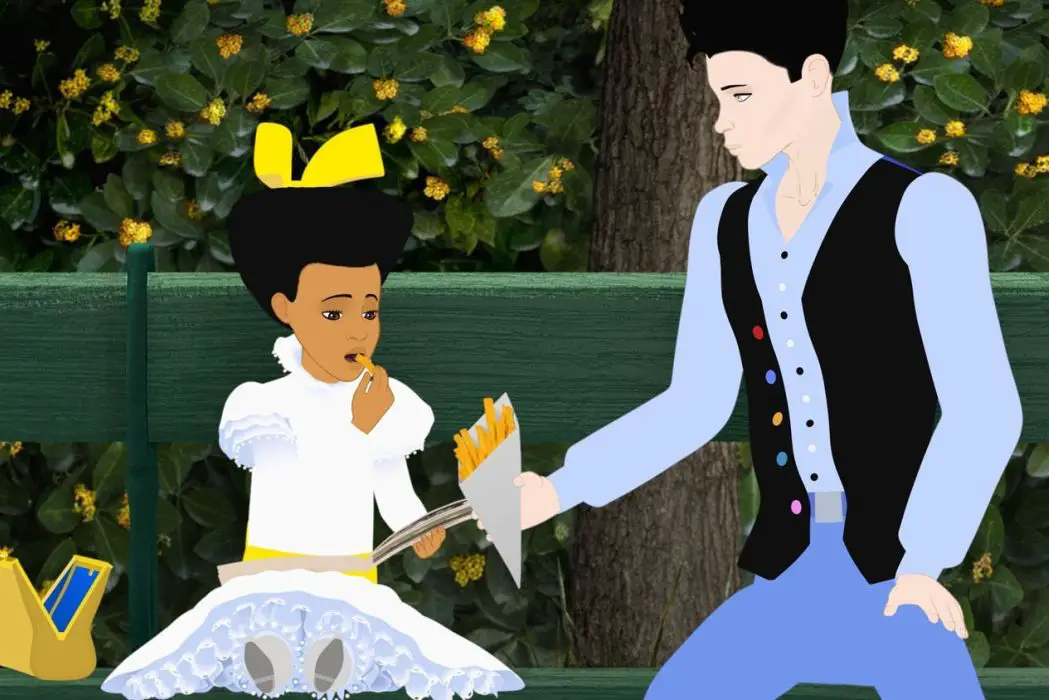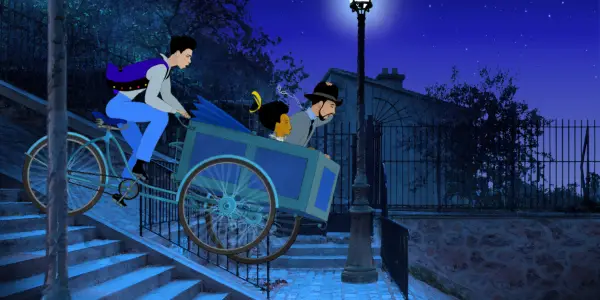DILILI IN PARIS: Reframing Paris Gets A Little Crooked

A writer of fiction and criticism, and English student based…
Michel Ocelot is one of the most celebrated figures in French animation that’s working today. In fact, the world of animation has a great manner of appreciation for him. Over the four decades of his career, Ocelot has taken the many forms in which his medium can be presented and utilized them in various ways, creating a mixed media kind of style that touches often on the power of storytelling and multiculturalism, most noted in his Kirikou series. There’s an undoubted heart behind the artistry as it is the messages he wishes to deliver, which makes him one of the medium’s core idealists.
His recent film, the Cesar Award-winning Dilili in Paris is in no way a deviation from that optimistic flavor. One might even say he’s at his most enthusiastic, as this is his first foray into covering the titular city of lights. Setting material in his native country after years of work that embraced and took inspiration from the likes of West Africa and elsewhere is about the only bold difference or act here. Everything else seems to offer what we’ve come to expect from the creator, but significantly less powerful in spite of its subject matter.
The Beautiful Age
Dilili (voiced by Prunelle Charles-Ambron in French and Angelina Carballo in the English dub) is a young girl living in Paris at the dawn of the 20th century, and bravely investigating a serious of crimes and abductions of young girls and women by an underground society called the Male-Masters. Being of mixed Kenak and French ancestry, a predictable amount of racism is targeted towards her. Being a little girl that probes her way into male-dominated spaces compounds on those prejudices, as her genuine interest in everything around her is belittled. She is not to be dissuaded though. Dilili possesses a Paddington Bear level of optimism, along with her friend Orel, a teenage delivery boy who knows the city and its people like the back of his hand. She was even lucky enough to be taught in school by Louise Michel, a legendary anarchist figure.

Michel is not the only great name of history to be found in the film. Set right in the midst of the Belle Époque, a period in which France’s most blooming era of creatives and intellectuals produced their best works, you’ll find as many famous faces as Woody Allen’s Midnight in Paris managed to fit, but set decades before. Some play a pivotal part in Dilili’s quest, like Michel, opera singer Emma Calvé, actress Sarah Bernhardt, and scientist Marie Curie. Most amount to a who’s who of cameo appearances that range in screentime, and include the lines of Claude Debussy, Marcel Proust, Louis Pasteur, Auguste Rodin, Claude Monet, Colette, Henri de Toulouse-Lautrec, and much more. Even King Edward VII’s visits to France are given a nod through a short appearance.
All of these people and the environments they frequented are complemented by Ocelot‘s usual mixing of visual styles, sticking to his guns of unshaded computer animation, but now placed against the backgrounds of real photographs that he took during and even before his research for the film. One thing’s certain, and that’s how his artistic sensibilities never falter.
It’s a unique blend of the modernity in CGI with the timelessness of Parisian architecture in a format that can’t be replicated. With the way mainstream animated films play safe in the medium, it’s welcome when one calls attention to the artificiality of computer animation and how freeing it can be to play with the stripped-down images.
A Case for the Present, Set in the Past
If one were to judge on its imagery alone, Dilili in Paris would go with few flaws, etched up as another positive marker in the Ocelot catalog. Cinema is more than just the moving image though, and when Dilili set itself up to deliver a message, it is more than fair to put as much expectation into that.
The aforementioned Male-Masters are established in the film as a dangerous force very early, one that’s misogynistic to a dehumanizing degree, and a direct threat to the citizens of Paris. By extension, the community of the Belle Époque is endangered because of what they stand for as evidence of progress and egalitarianism. Dilili shows how interactive and well-connected these artists, philosophers, and professionals are, never trying to be better than one another, but praising and influencing each other. Promoting equality and growing modernism as the positive force of the film makes for a powerful takeaway, and no doubt will resonate with the target audience in a way they can understand.

Dilili herself is a bit harder to decipher aside from the surface. Her ethnicity is made a point of in the film’s opening minutes, but where it hints at her facing two variations of racial discrimination (being to European for Kanak people, and too black for the French), there’s a shocking lack of acknowledging the racial issue. This can be taken as Ocelot understanding what is and isn’t his place to discuss, or not wanting to bog down a family film with heavier themes than it already has, but one wonders how Dilili’s lack of care towards the prejudices could be taken as brushing off France’s own problematic history.
The film opens with her in one of Paris’ regrettable exotic exhibitions, a flattering name for “human zoos,” but never addresses her feelings on being displayed in a degradation of her culture. Even within the creative circle, the film brushes right over their connections to prejudice with an appearance from painter Edgar Degas, known for Dancer Taking a Bow about as much as being a vicious anti-Semite. It’s more concerned with cramming names in that the ramifications of such.
Earlier, this review mentioned Dilili being similar to Paddington, and that can go double for the films they’re a part of. The difference lies in Paddington having a protagonist that’s able to operate as an active part and revelation in the changes of London. It’s wishful thinking that it takes a small bear to reform the prison system, but we know he has the capacity to do so through his generosity. Dilili has the same virtues, but her determination and intellect come off as more naive when her main interactions revolve around the idealized image of a famous collective. It’s a moral delivered in style, but seems to look over its own biases to have a full read on what should be held responsible in the fight for social change.
Dilili in Paris: Conclusion
The central themes are well-intended, and are effective in their simplest form. What it accomplishes weigh more than the stumbling blocks, but the blocks do exist regardless. Michel Ocelot has always been one to apply the breadth of his creativity towards an easy narrative, but only here does it prove to be something of a barrier to what can be more fulfilling.
At the end of the day, Dilili in Paris reaches its intended demographic with grace and a liberal amount of playfulness, truly embodying the gleeful period of French history it embeds itself within. Nothing but love and happiness exudes from the frames we’re presented, and that just might be enough to counteract the reservations in their eyes. The lingering feeling of something missing still carries though, and this reviewer is left to ponder.
What are some other great French animated films that deserve attention? Is a message enough to convince a film for you?
Watch Dilili in Paris
Does content like this matter to you?
Become a Member and support film journalism. Unlock access to all of Film Inquiry`s great articles. Join a community of like-minded readers who are passionate about cinema - get access to our private members Network, give back to independent filmmakers, and more.
A writer of fiction and criticism, and English student based in Baltimore. Berry’s aspirations of becoming an animator/filmmaker started young. It was a high school film studies course that shifted their interest to wanting to discuss them. They maintain a growing list of favorite films, ranging from Ingmar Bergman’s Persona to Stephen King’s Maximum Overdrive.












